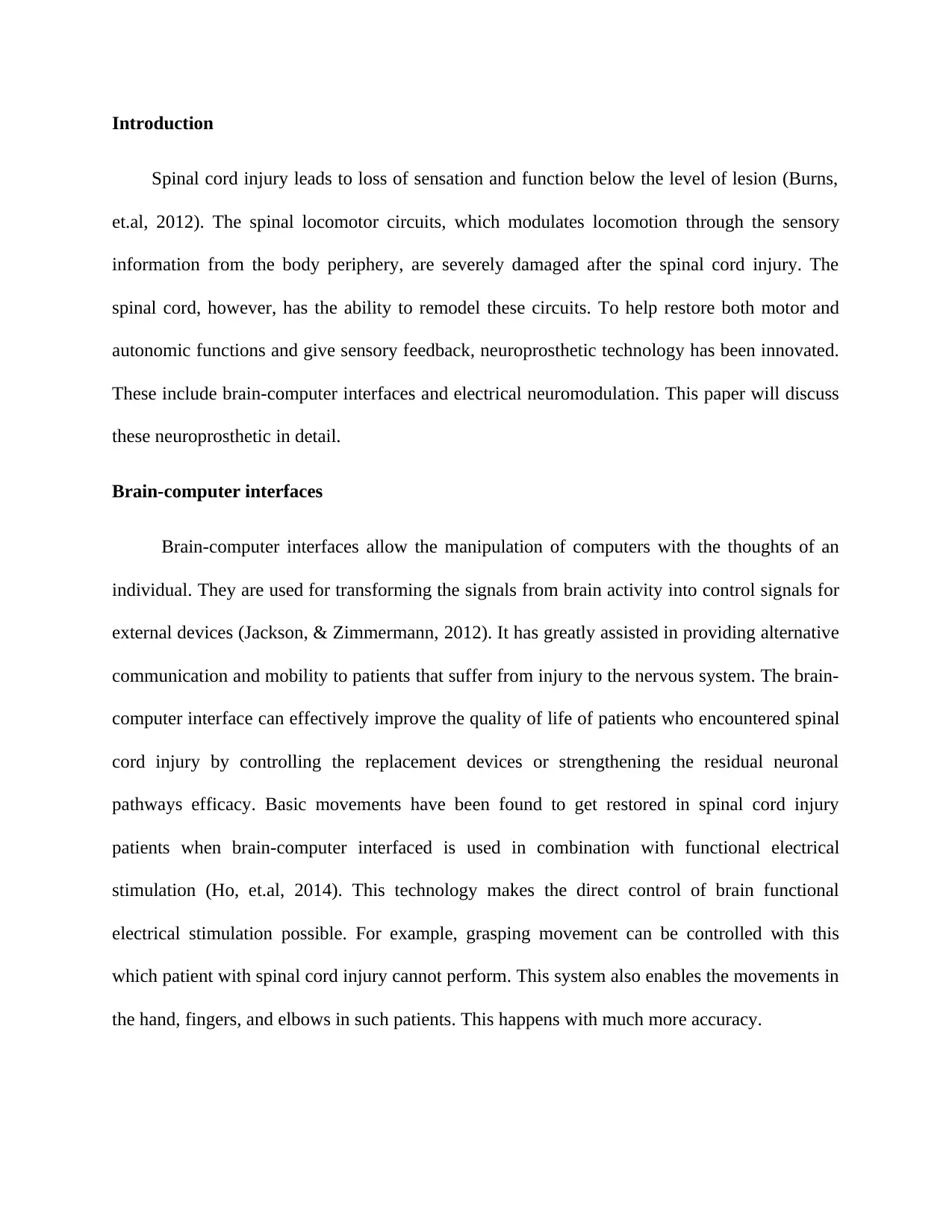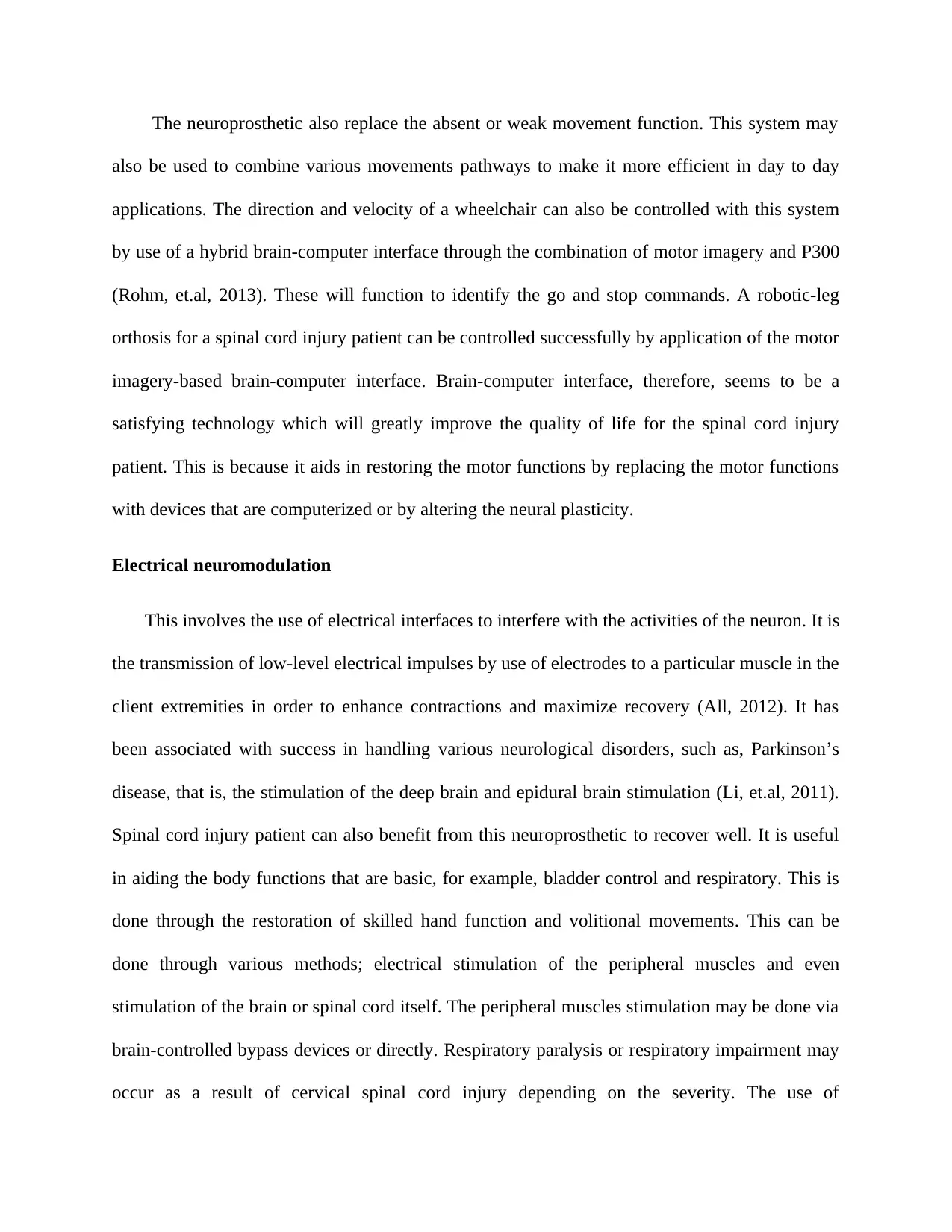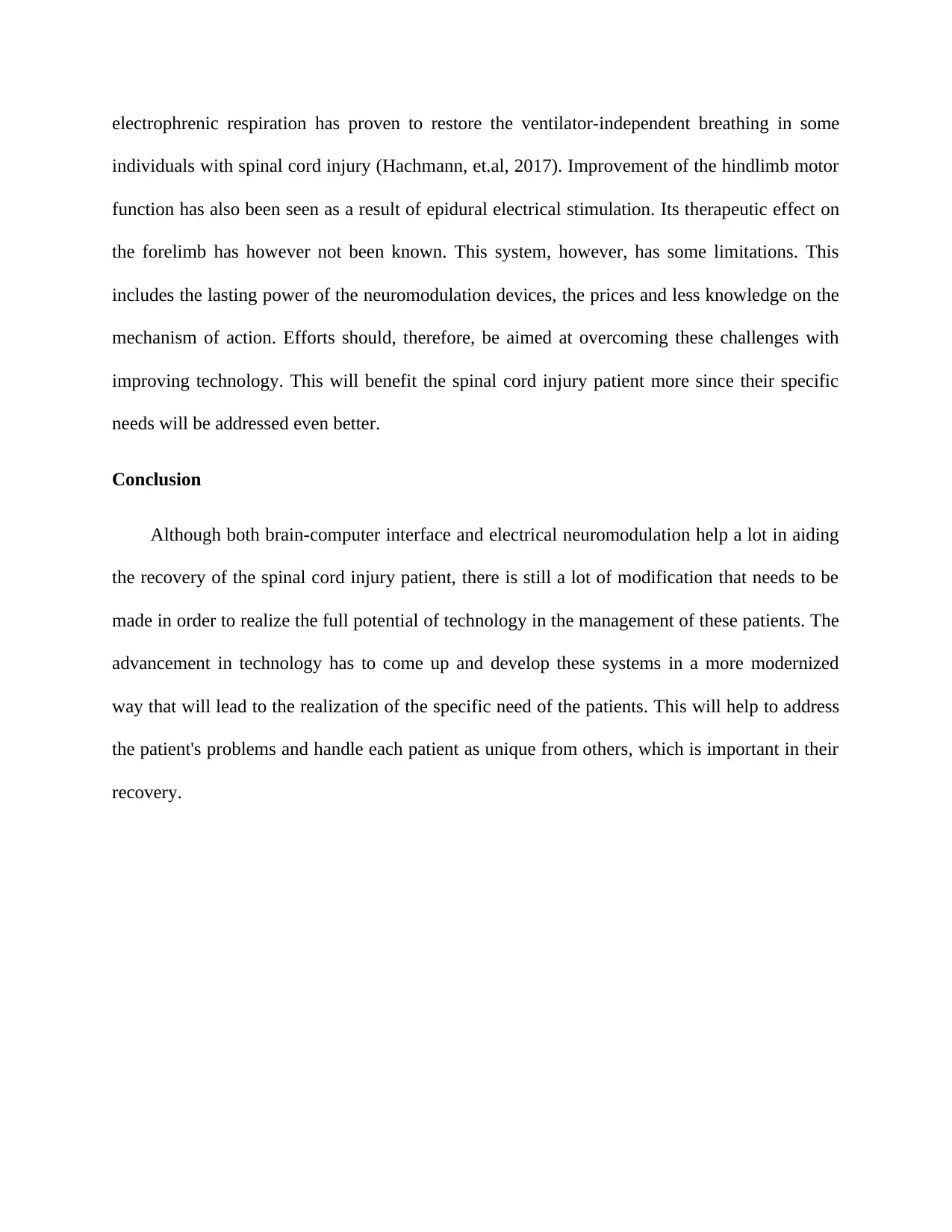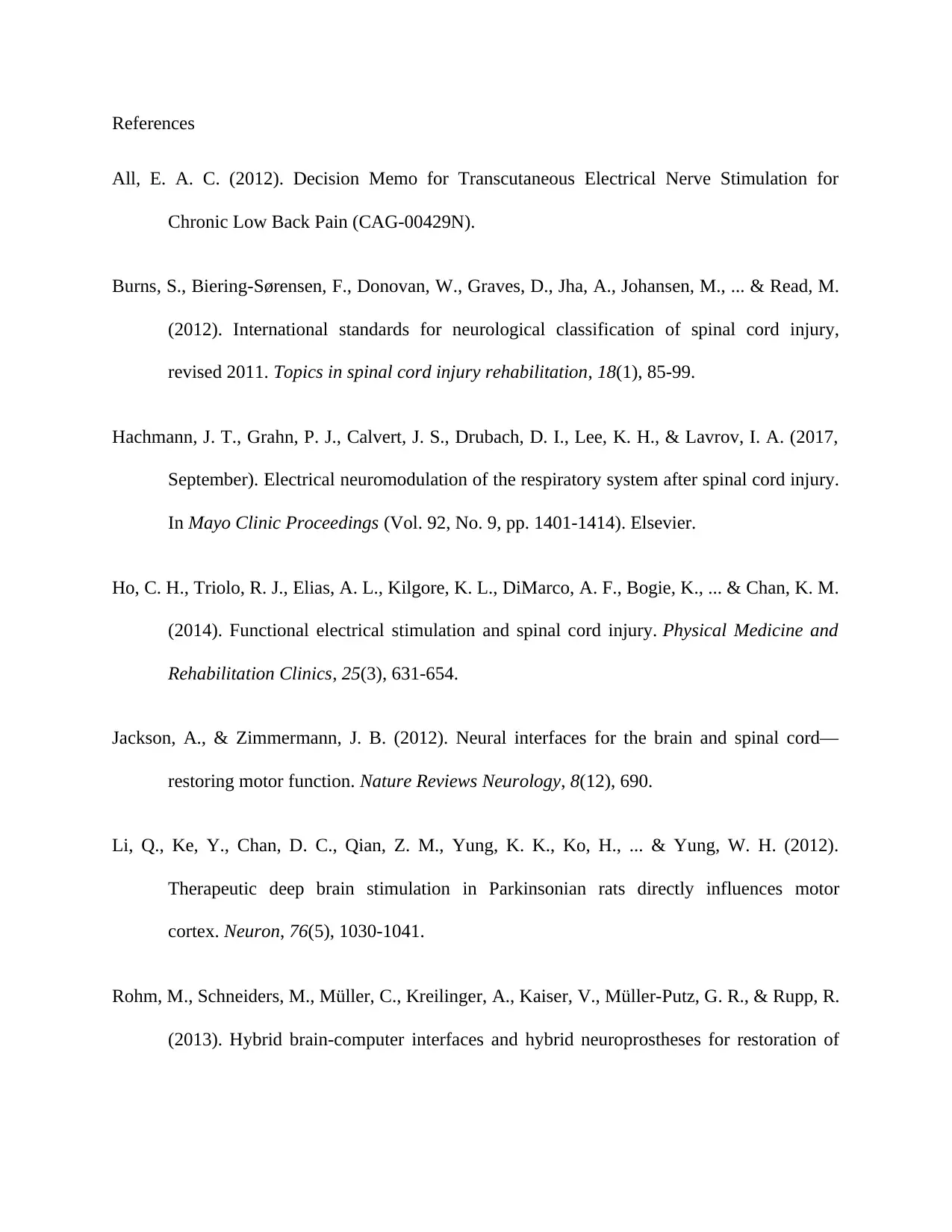Neuroprosthetic Applications: Brain-Computer Interface for SCI Rehab
VerifiedAdded on 2023/04/19
|6
|1249
|61
Report
AI Summary
This report explores the use of neuroprosthetic technologies, specifically brain-computer interfaces (BCIs) and electrical neuromodulation, in the rehabilitation of spinal cord injury (SCI) patients. It details how BCIs translate brain activity into control signals for external devices, restoring motor functions and improving the quality of life for individuals with SCI by enabling control of replacement devices and strengthening residual neuronal pathways. The report also discusses electrical neuromodulation, which uses electrical impulses to stimulate muscles and restore basic body functions like bladder control and breathing, highlighting the potential of electrophrenic respiration to restore ventilator-independent breathing. While both technologies show promise, the report concludes that further advancements are needed to fully realize their potential and address the specific needs of individual patients for more effective SCI management. Desklib offers a range of similar solved assignments and past papers for students.

Neuroscience
Student’s name:
Institutional:
Student’s name:
Institutional:
Paraphrase This Document
Need a fresh take? Get an instant paraphrase of this document with our AI Paraphraser

Introduction
Spinal cord injury leads to loss of sensation and function below the level of lesion (Burns,
et.al, 2012). The spinal locomotor circuits, which modulates locomotion through the sensory
information from the body periphery, are severely damaged after the spinal cord injury. The
spinal cord, however, has the ability to remodel these circuits. To help restore both motor and
autonomic functions and give sensory feedback, neuroprosthetic technology has been innovated.
These include brain-computer interfaces and electrical neuromodulation. This paper will discuss
these neuroprosthetic in detail.
Brain-computer interfaces
Brain-computer interfaces allow the manipulation of computers with the thoughts of an
individual. They are used for transforming the signals from brain activity into control signals for
external devices (Jackson, & Zimmermann, 2012). It has greatly assisted in providing alternative
communication and mobility to patients that suffer from injury to the nervous system. The brain-
computer interface can effectively improve the quality of life of patients who encountered spinal
cord injury by controlling the replacement devices or strengthening the residual neuronal
pathways efficacy. Basic movements have been found to get restored in spinal cord injury
patients when brain-computer interfaced is used in combination with functional electrical
stimulation (Ho, et.al, 2014). This technology makes the direct control of brain functional
electrical stimulation possible. For example, grasping movement can be controlled with this
which patient with spinal cord injury cannot perform. This system also enables the movements in
the hand, fingers, and elbows in such patients. This happens with much more accuracy.
Spinal cord injury leads to loss of sensation and function below the level of lesion (Burns,
et.al, 2012). The spinal locomotor circuits, which modulates locomotion through the sensory
information from the body periphery, are severely damaged after the spinal cord injury. The
spinal cord, however, has the ability to remodel these circuits. To help restore both motor and
autonomic functions and give sensory feedback, neuroprosthetic technology has been innovated.
These include brain-computer interfaces and electrical neuromodulation. This paper will discuss
these neuroprosthetic in detail.
Brain-computer interfaces
Brain-computer interfaces allow the manipulation of computers with the thoughts of an
individual. They are used for transforming the signals from brain activity into control signals for
external devices (Jackson, & Zimmermann, 2012). It has greatly assisted in providing alternative
communication and mobility to patients that suffer from injury to the nervous system. The brain-
computer interface can effectively improve the quality of life of patients who encountered spinal
cord injury by controlling the replacement devices or strengthening the residual neuronal
pathways efficacy. Basic movements have been found to get restored in spinal cord injury
patients when brain-computer interfaced is used in combination with functional electrical
stimulation (Ho, et.al, 2014). This technology makes the direct control of brain functional
electrical stimulation possible. For example, grasping movement can be controlled with this
which patient with spinal cord injury cannot perform. This system also enables the movements in
the hand, fingers, and elbows in such patients. This happens with much more accuracy.

The neuroprosthetic also replace the absent or weak movement function. This system may
also be used to combine various movements pathways to make it more efficient in day to day
applications. The direction and velocity of a wheelchair can also be controlled with this system
by use of a hybrid brain-computer interface through the combination of motor imagery and P300
(Rohm, et.al, 2013). These will function to identify the go and stop commands. A robotic-leg
orthosis for a spinal cord injury patient can be controlled successfully by application of the motor
imagery-based brain-computer interface. Brain-computer interface, therefore, seems to be a
satisfying technology which will greatly improve the quality of life for the spinal cord injury
patient. This is because it aids in restoring the motor functions by replacing the motor functions
with devices that are computerized or by altering the neural plasticity.
Electrical neuromodulation
This involves the use of electrical interfaces to interfere with the activities of the neuron. It is
the transmission of low-level electrical impulses by use of electrodes to a particular muscle in the
client extremities in order to enhance contractions and maximize recovery (All, 2012). It has
been associated with success in handling various neurological disorders, such as, Parkinson’s
disease, that is, the stimulation of the deep brain and epidural brain stimulation (Li, et.al, 2011).
Spinal cord injury patient can also benefit from this neuroprosthetic to recover well. It is useful
in aiding the body functions that are basic, for example, bladder control and respiratory. This is
done through the restoration of skilled hand function and volitional movements. This can be
done through various methods; electrical stimulation of the peripheral muscles and even
stimulation of the brain or spinal cord itself. The peripheral muscles stimulation may be done via
brain-controlled bypass devices or directly. Respiratory paralysis or respiratory impairment may
occur as a result of cervical spinal cord injury depending on the severity. The use of
also be used to combine various movements pathways to make it more efficient in day to day
applications. The direction and velocity of a wheelchair can also be controlled with this system
by use of a hybrid brain-computer interface through the combination of motor imagery and P300
(Rohm, et.al, 2013). These will function to identify the go and stop commands. A robotic-leg
orthosis for a spinal cord injury patient can be controlled successfully by application of the motor
imagery-based brain-computer interface. Brain-computer interface, therefore, seems to be a
satisfying technology which will greatly improve the quality of life for the spinal cord injury
patient. This is because it aids in restoring the motor functions by replacing the motor functions
with devices that are computerized or by altering the neural plasticity.
Electrical neuromodulation
This involves the use of electrical interfaces to interfere with the activities of the neuron. It is
the transmission of low-level electrical impulses by use of electrodes to a particular muscle in the
client extremities in order to enhance contractions and maximize recovery (All, 2012). It has
been associated with success in handling various neurological disorders, such as, Parkinson’s
disease, that is, the stimulation of the deep brain and epidural brain stimulation (Li, et.al, 2011).
Spinal cord injury patient can also benefit from this neuroprosthetic to recover well. It is useful
in aiding the body functions that are basic, for example, bladder control and respiratory. This is
done through the restoration of skilled hand function and volitional movements. This can be
done through various methods; electrical stimulation of the peripheral muscles and even
stimulation of the brain or spinal cord itself. The peripheral muscles stimulation may be done via
brain-controlled bypass devices or directly. Respiratory paralysis or respiratory impairment may
occur as a result of cervical spinal cord injury depending on the severity. The use of
⊘ This is a preview!⊘
Do you want full access?
Subscribe today to unlock all pages.

Trusted by 1+ million students worldwide

electrophrenic respiration has proven to restore the ventilator-independent breathing in some
individuals with spinal cord injury (Hachmann, et.al, 2017). Improvement of the hindlimb motor
function has also been seen as a result of epidural electrical stimulation. Its therapeutic effect on
the forelimb has however not been known. This system, however, has some limitations. This
includes the lasting power of the neuromodulation devices, the prices and less knowledge on the
mechanism of action. Efforts should, therefore, be aimed at overcoming these challenges with
improving technology. This will benefit the spinal cord injury patient more since their specific
needs will be addressed even better.
Conclusion
Although both brain-computer interface and electrical neuromodulation help a lot in aiding
the recovery of the spinal cord injury patient, there is still a lot of modification that needs to be
made in order to realize the full potential of technology in the management of these patients. The
advancement in technology has to come up and develop these systems in a more modernized
way that will lead to the realization of the specific need of the patients. This will help to address
the patient's problems and handle each patient as unique from others, which is important in their
recovery.
individuals with spinal cord injury (Hachmann, et.al, 2017). Improvement of the hindlimb motor
function has also been seen as a result of epidural electrical stimulation. Its therapeutic effect on
the forelimb has however not been known. This system, however, has some limitations. This
includes the lasting power of the neuromodulation devices, the prices and less knowledge on the
mechanism of action. Efforts should, therefore, be aimed at overcoming these challenges with
improving technology. This will benefit the spinal cord injury patient more since their specific
needs will be addressed even better.
Conclusion
Although both brain-computer interface and electrical neuromodulation help a lot in aiding
the recovery of the spinal cord injury patient, there is still a lot of modification that needs to be
made in order to realize the full potential of technology in the management of these patients. The
advancement in technology has to come up and develop these systems in a more modernized
way that will lead to the realization of the specific need of the patients. This will help to address
the patient's problems and handle each patient as unique from others, which is important in their
recovery.
Paraphrase This Document
Need a fresh take? Get an instant paraphrase of this document with our AI Paraphraser

References
All, E. A. C. (2012). Decision Memo for Transcutaneous Electrical Nerve Stimulation for
Chronic Low Back Pain (CAG-00429N).
Burns, S., Biering-Sørensen, F., Donovan, W., Graves, D., Jha, A., Johansen, M., ... & Read, M.
(2012). International standards for neurological classification of spinal cord injury,
revised 2011. Topics in spinal cord injury rehabilitation, 18(1), 85-99.
Hachmann, J. T., Grahn, P. J., Calvert, J. S., Drubach, D. I., Lee, K. H., & Lavrov, I. A. (2017,
September). Electrical neuromodulation of the respiratory system after spinal cord injury.
In Mayo Clinic Proceedings (Vol. 92, No. 9, pp. 1401-1414). Elsevier.
Ho, C. H., Triolo, R. J., Elias, A. L., Kilgore, K. L., DiMarco, A. F., Bogie, K., ... & Chan, K. M.
(2014). Functional electrical stimulation and spinal cord injury. Physical Medicine and
Rehabilitation Clinics, 25(3), 631-654.
Jackson, A., & Zimmermann, J. B. (2012). Neural interfaces for the brain and spinal cord—
restoring motor function. Nature Reviews Neurology, 8(12), 690.
Li, Q., Ke, Y., Chan, D. C., Qian, Z. M., Yung, K. K., Ko, H., ... & Yung, W. H. (2012).
Therapeutic deep brain stimulation in Parkinsonian rats directly influences motor
cortex. Neuron, 76(5), 1030-1041.
Rohm, M., Schneiders, M., Müller, C., Kreilinger, A., Kaiser, V., Müller-Putz, G. R., & Rupp, R.
(2013). Hybrid brain-computer interfaces and hybrid neuroprostheses for restoration of
All, E. A. C. (2012). Decision Memo for Transcutaneous Electrical Nerve Stimulation for
Chronic Low Back Pain (CAG-00429N).
Burns, S., Biering-Sørensen, F., Donovan, W., Graves, D., Jha, A., Johansen, M., ... & Read, M.
(2012). International standards for neurological classification of spinal cord injury,
revised 2011. Topics in spinal cord injury rehabilitation, 18(1), 85-99.
Hachmann, J. T., Grahn, P. J., Calvert, J. S., Drubach, D. I., Lee, K. H., & Lavrov, I. A. (2017,
September). Electrical neuromodulation of the respiratory system after spinal cord injury.
In Mayo Clinic Proceedings (Vol. 92, No. 9, pp. 1401-1414). Elsevier.
Ho, C. H., Triolo, R. J., Elias, A. L., Kilgore, K. L., DiMarco, A. F., Bogie, K., ... & Chan, K. M.
(2014). Functional electrical stimulation and spinal cord injury. Physical Medicine and
Rehabilitation Clinics, 25(3), 631-654.
Jackson, A., & Zimmermann, J. B. (2012). Neural interfaces for the brain and spinal cord—
restoring motor function. Nature Reviews Neurology, 8(12), 690.
Li, Q., Ke, Y., Chan, D. C., Qian, Z. M., Yung, K. K., Ko, H., ... & Yung, W. H. (2012).
Therapeutic deep brain stimulation in Parkinsonian rats directly influences motor
cortex. Neuron, 76(5), 1030-1041.
Rohm, M., Schneiders, M., Müller, C., Kreilinger, A., Kaiser, V., Müller-Putz, G. R., & Rupp, R.
(2013). Hybrid brain-computer interfaces and hybrid neuroprostheses for restoration of

upper limb functions in individuals with high-level spinal cord injury. Artificial
intelligence in medicine, 59(2), 133-142.
intelligence in medicine, 59(2), 133-142.
⊘ This is a preview!⊘
Do you want full access?
Subscribe today to unlock all pages.

Trusted by 1+ million students worldwide
1 out of 6
Related Documents
Your All-in-One AI-Powered Toolkit for Academic Success.
+13062052269
info@desklib.com
Available 24*7 on WhatsApp / Email
![[object Object]](/_next/static/media/star-bottom.7253800d.svg)
Unlock your academic potential
Copyright © 2020–2025 A2Z Services. All Rights Reserved. Developed and managed by ZUCOL.




